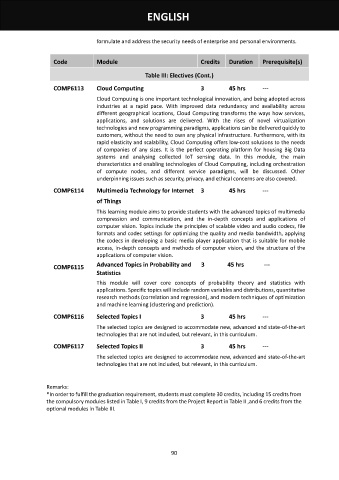Page 96 - 2025.2026 - 澳門理工大學研究生課程手冊(電子書)
P. 96
ENGLISH
Code Module Credits Duration Prerequisite(s)
Table III: Electives (Cont.)
COMP6113 Cloud Computing 3 45 hrs ---
Cloud Computing is one important technological innovation, and being adopted across
industries at a rapid pace. With improved data redundancy and availability across
different geographical locations, Cloud Computing transforms the ways how services,
applications, and solutions are delivered. With the rises of novel virtualization
technologies and new programming paradigms, applications can be delivered quickly to
customers, without the need to own any physical infrastructure. Furthermore, with its
rapid elasticity and scalability, Cloud Computing offers low-cost solutions to the needs
of companies of any sizes. It is the perfect operating platform for housing Big Data
systems and analysing collected IoT sensing data. In this module, the main
characteristics and enabling technologies of Cloud Computing, including orchestration
of compute nodes, and different service paradigms, will be discussed. Other
underpinning issues such as security, privacy, and ethical concerns are also covered.
COMP6114 Multimedia Technology for Internet 3 45 hrs ---
of Things
This learning module aims to provide students with the advanced topics of multimedia
compression and communication, and the in-depth concepts and applications of
computer vision. Topics include the principles of scalable video and audio codecs, file
formats and codec settings for optimizing the quality and media bandwidth, applying
the codecs in developing a basic media player application that is suitable for mobile
access, in-depth concepts and methods of computer vision, and the structure of the
applications of computer vision.
Advanced Topics in Probability and 3 45 hrs ---
COMP6115
Statistics
This module will cover core concepts of probability theory and statistics with
applications. Specific topics will include random variables and distributions, quantitative
research methods (correlation and regression), and modern techniques of optimization
and machine learning (clustering and prediction).
COMP6116 Selected Topics I 3 45 hrs ---
The selected topics are designed to accommodate new, advanced and state-of-the-art
technologies that are not included, but relevant, in this curriculum.
COMP6117 Selected Topics II 3 45 hrs ---
The selected topics are designed to accommodate new, advanced and state-of-the-art
technologies that are not included, but relevant, in this curriculum.
Remarks:
*In order to fulfill the graduation requirement, students must complete 30 credits, including 15 credits from
the compulsory modules listed in Table I, 9 credits from the Project Report in Table II ,and 6 credits from the
optional modules in Table III.
90

